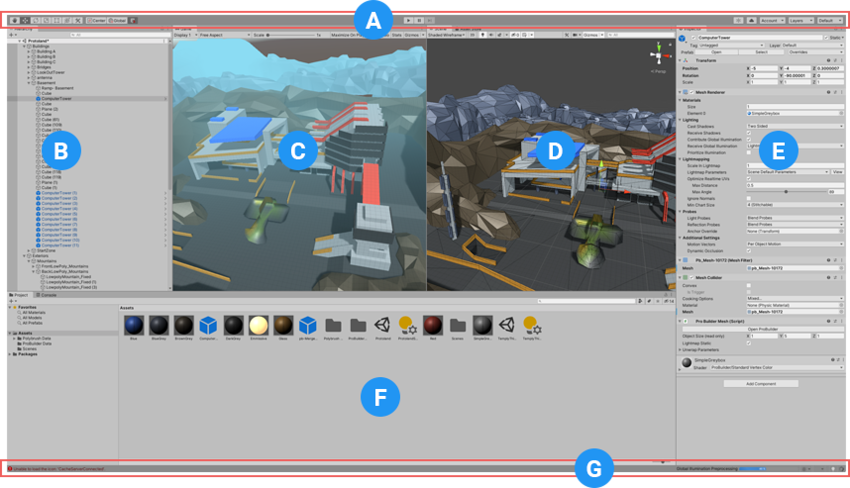Unity’s interface
This section provides a detailed tour of the most common editor windows, and how to make full use of them.

-
(A) The Toolbar provides access to the most essential working features. On the left it contains the basic tools for manipulating the Scene viewAn interactive view into the world you are creating. You use the Scene View to select and position scenery, characters, cameras, lights, and all other types of Game Object. More info
See in Glossary and the GameObjectsThe fundamental object in Unity scenes, which can represent characters, props, scenery, cameras, waypoints, and more. A GameObject’s functionality is defined by the Components attached to it. More info
See in Glossary within it. In the centre are the play, pause and step controls. The buttons to the right give you access to Unity Collaborate, Unity Cloud Services and your Unity Account, followed by a layer visibility menu, and finally the Editor layout menu (which provides some alternate layouts for the Editor windows, and allows you to save your own custom layouts). -
(B) The Hierarchy window is a hierarchical text representation of every GameObject in the SceneA Scene contains the environments and menus of your game. Think of each unique Scene file as a unique level. In each Scene, you place your environments, obstacles, and decorations, essentially designing and building your game in pieces. More info
See in Glossary. Each item in the Scene has an entry in the hierarchy, so the two windows are inherently linked. The hierarchy reveals the structure of how GameObjects attach to each another. -
(C) The Game view simulates what your final rendered game will look like through your Scene CamerasA component which creates an image of a particular viewpoint in your scene. The output is either drawn to the screen or captured as a texture. More info
See in Glossary. When you click the Play button, the simulation begins. - (D) The Scene view allows you to visually navigate and edit your Scene. The Scene view can show a 3D or 2D perspective, depending on the type of Project you are working on.
-
(E) The Inspector Window allows you to view and edit all the properties of the currently selected GameObject. Because different types of GameObjects have different sets of properties, the layout and contents of the InspectorA Unity window that displays information about the currently selected GameObject, asset or project settings, allowing you to inspect and edit the values. More info
See in Glossary window change each time you select a different GameObject. - (F) The Project window displays your library of Assets that are available to use in your Project. When you import Assets into your Project, they appear here.
- (G) The status bar provides notifications about various Unity processes, and quick access to related tools and settings.
Copyright © 2023 Unity Technologies
优美缔软件(上海)有限公司 版权所有
"Unity"、Unity 徽标及其他 Unity 商标是 Unity Technologies 或其附属机构在美国及其他地区的商标或注册商标。其他名称或品牌是其各自所有者的商标。
公安部备案号:
31010902002961